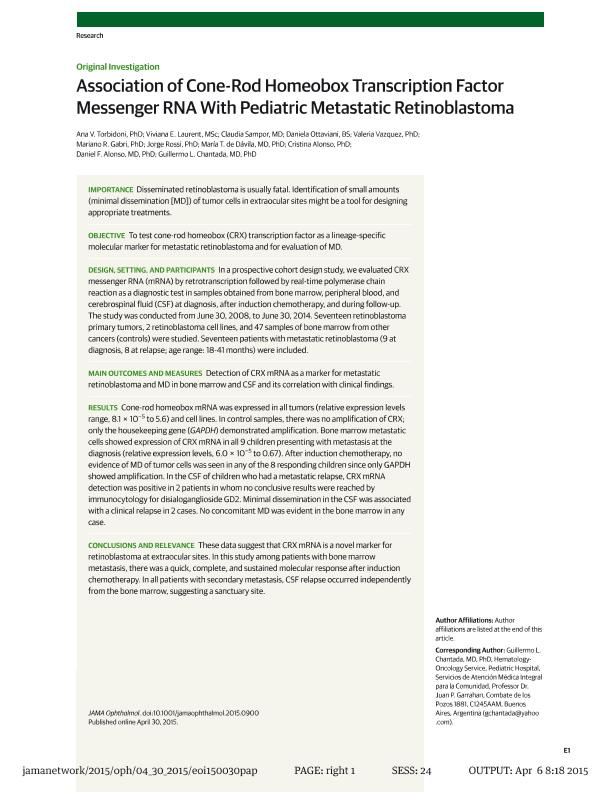Artículo
Association of cone-rod homeobox transcription factor messenger RNA with pediatric metastatic retinoblastoma
Torbidoni, Ana Vanesa ; Laurent, Viviana Eunice
; Laurent, Viviana Eunice ; Sampor, Claudia; Ottaviani, Daniela; Vazquez, Valeria; Gabri, Mariano Rolando
; Sampor, Claudia; Ottaviani, Daniela; Vazquez, Valeria; Gabri, Mariano Rolando ; Vazquez Rossi, Jorge Eduardo; Garcia de Davila, Maria Teresa; Alonso, Cristina; Alonso, Daniel Fernando
; Vazquez Rossi, Jorge Eduardo; Garcia de Davila, Maria Teresa; Alonso, Cristina; Alonso, Daniel Fernando ; Chantada, Guillermo Luis
; Chantada, Guillermo Luis
 ; Laurent, Viviana Eunice
; Laurent, Viviana Eunice ; Sampor, Claudia; Ottaviani, Daniela; Vazquez, Valeria; Gabri, Mariano Rolando
; Sampor, Claudia; Ottaviani, Daniela; Vazquez, Valeria; Gabri, Mariano Rolando ; Vazquez Rossi, Jorge Eduardo; Garcia de Davila, Maria Teresa; Alonso, Cristina; Alonso, Daniel Fernando
; Vazquez Rossi, Jorge Eduardo; Garcia de Davila, Maria Teresa; Alonso, Cristina; Alonso, Daniel Fernando ; Chantada, Guillermo Luis
; Chantada, Guillermo Luis
Fecha de publicación:
07/2015
Editorial:
American Medical Association
Revista:
JAMA Ophthalmology
ISSN:
2168-6165
Idioma:
Inglés
Tipo de recurso:
Artículo publicado
Clasificación temática:
Resumen
IMPORTANCE: Disseminated retinoblastoma is usually fatal. Identification of small amounts (minimal dissemination [MD]) of tumor cells in extraocular sites might be a tool for designing appropriate treatments. OBJECTIVE: To test cone-rod homeobox (CRX) transcription factor as a lineage-specific molecular marker for metastatic retinoblastoma and for evaluation of MD. DESIGN, SETTING, AND PARTICIPANTS: In a prospective cohort design study, we evaluated CRX messenger RNA (mRNA) by retrotranscription followed by real-time polymerase chain reaction as a diagnostic test in samples obtained from bone marrow, peripheral blood, and cerebrospinal fluid (CSF) at diagnosis, after induction chemotherapy, and during follow-up. The study was conducted from June 30, 2008, to June 30, 2014. Seventeen retinoblastoma primary tumors, 2 retinoblastoma cell lines, and 47 samples of bone marrow from other cancers (controls) were studied. Seventeen patients with metastatic retinoblastoma (9 at diagnosis, 8 at relapse; age range: 18-41 months) were included. MAIN OUTCOMES AND MEASURES: Detection of CRX mRNA as a marker for metastatic retinoblastoma and MD in bone marrow and CSF and its correlation with clinical findings. RESULTS: Cone-rod homeobox mRNA was expressed in all tumors (relative expression levels range, 8.1 × 10-5 to 5.6) and cell lines. In control samples, there was no amplification of CRX; only the housekeeping gene (GAPDH) demonstrated amplification. Bone marrow metastatic cells showed expression of CRX mRNA in all 9 children presenting with metastasis at the diagnosis (relative expression levels, 6.0 × 10-5 to 0.67). After induction chemotherapy, no evidence of MD of tumor cells was seen in any of the 8 responding children since only GAPDH showed amplification. In the CSF of children who had a metastatic relapse, CRX mRNA detection was positive in 2 patients in whom no conclusive results were reached by immunocytology for disialoganglioside GD2. Minimal dissemination in the CSF was associated with a clinical relapse in 2 cases. No concomitant MD was evident in the bone marrow in any case. CONCLUSIONS AND RELEVANCE: These data suggest that CRX mRNA is a novel marker for retinoblastoma at extraocular sites. In this study among patients with bone marrow metastasis, there was a quick, complete, and sustained molecular response after induction chemotherapy. In all patients with secondary metastasis, CSF relapse occurred independently from the bone marrow, suggesting a sanctuary site.
Archivos asociados
Licencia
Identificadores
Colecciones
Articulos(SEDE CENTRAL)
Articulos de SEDE CENTRAL
Articulos de SEDE CENTRAL
Citación
Torbidoni, Ana Vanesa; Laurent, Viviana Eunice; Sampor, Claudia; Ottaviani, Daniela; Vazquez, Valeria; et al.; Association of cone-rod homeobox transcription factor messenger RNA with pediatric metastatic retinoblastoma; American Medical Association; JAMA Ophthalmology; 133; 7; 7-2015; 805-812
Compartir
Altmétricas



